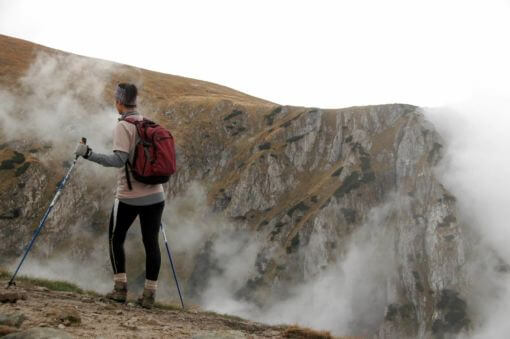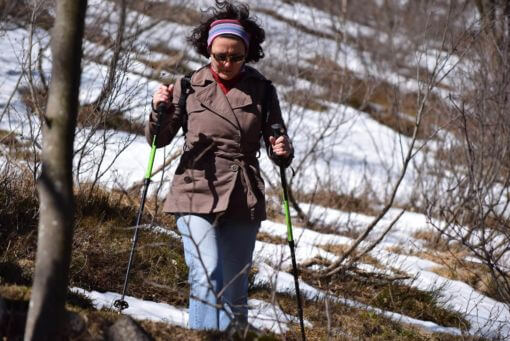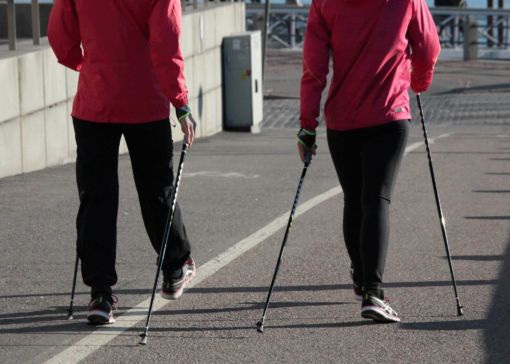How To Choose Nordic Walking Poles And Walking Sticks – Expert Advice
Choosing the Best Nordic Walking Poles, Fitness Walking Poles and Walking Sticks

TOP RATED Pro Walker Nordic Fitness Poles
"Never felt better and doctor approves!"

BEST SELLER 3K Carbon Fiber Trekking Poles
“One of the most innovative designs.”

TRENDING Ultra Z Folding Trekking Poles
“Amazing quick lock system.”

While some people enjoy the exhaustion that accompanies high-intensity exercises, most people exercise despite the way it wears them out. But exhaustion is a necessary part of a high-intensity exercise, right? As it turns out, the answer is no. There is at least one type of exercise – Nordic walking – that actually elevates your heart rate to a high level, without causing you to feel like you are working very hard. In fact, when compared to regular walking, Nordic walking triggers a higher heart rate, without increasing the level of effort you must provide. In fact, many people who try Nordic walking actually find that it is easier than normal walking. But, before you can start enjoying the benefits of this new exercise, you’ll need to obtain a bit of equipment first – you’ll need a pair of Nordic walking poles, also know as fitness walking poles. But before you just plop down the plastic and buy the first pair of Nordic walking poles you see, you’ll want to learn how to select the best pair for your needs. We’ll discuss the basics of Nordic walking and Nordic walking poles, otherwise know just as walking poles, explain the benefits they provide and list the characteristics and features you’ll want to look for when making your selection. We’ll also explain how to determine the best size poles for your body.
Shop Montem’s Selection of Nordic Poles
What Are The Benefits Of Nordic Walking?
Originally called Finnish Sauvakävely, Nordic walking first became popular in 1979, thanks to the work of Mauri Repo. The basic techniques used in Nordic walking have been used by cross-country skiers for many years, but this was the first time the principles had been applied to walking in a comprehensive manner. Originally intended as an off-season workout for cross-country skiers, Nordic walking provides a great workout and benefits your entire body. Specifically, Nordic walking provides greater value than traditional walking because of they:
- Involves more muscle groups, particularly of the upper body when compared to regular walking
- Increases energy use (calories burned) when compared to regular walking
- Increases oxygen consumption when compared to regular walking
- Increases heart rate when compared to regular walking
- Increases muscle strength more than walking does
- Provides a better intensity-to-impact ratio than traditional walking does
Nordic walking also offers additional benefits to some people. For example, it may allow those with minor disabilities or health concerns to exercise when they wouldn’t be able to do so otherwise. It may also be a good option for those who are trying to multi-task. For example, if your normal day-to-day life requires you to walk long distances, you can adopt Nordic walking techniques to fit some exercise into your day.
What Types of People Will Benefit Most from Nordic Walking?
Most people can enjoy the benefits Nordic walking provides, but some people are especially well-suited for the activity. This includes:
- People who have difficulty keeping their balance
- People recovering from injuries
- Those who want to increase the intensity of daily walks
- Athletes interested in working their muscles in different ways
- People who find treadmills and similar devices boring to use
- People looking for a high-intensity, yet relatively low-impact exercise
- Families who would like to exercise in a way that everyone can enjoy
- Those who like to get their exercise while enjoying the great outdoors
Nordic walking doesn’t differ significantly from normal walking in terms of safety. It may even be safer; thanks to the improved balance and stability the poles can provide. However, if you are new to exercise or have any health problems, it is wise to speak with your doctor first before beginning any exercise regimen.
Shop Montem’s Selection of Walking Sticks
What Are Nordic Walking Poles?
At a glance, Nordic walking poles resemble standard trekking poles or ski poles, which are popular among walkers, hikers and others who like to travel by foot. Walking poles are made of similar materials and include a few of the same features, such as grips, wrist straps and tips. However, there are a few differences between Nordic walking poles and ski poles or trekking poles.
- Nordic walking poles are typically shorter than ski poles and some trekking poles
- Nordic walking poles have slightly different grips than trekking or ski poles do
- Nordic walking poles typically have specialized wrist straps or demi-gloves
Nordic walking poles usually have tips that are designed to work best on various surfaces, and some feature multi-tips, which are designed to work on different substrates. Some models are adjustable, while others have a fixed length, and they are made of one of several materials, although carbon fiber and aluminum are the most common. In summary, Nordic walking poles are different than hiking poles and ski poles since they have detachable pads for hard surfaces and a glove that clicks into the pole to ensure your hand is in the right position.
How Do I Choose A Nordic Walking Stick?

Nordic poles are not one-size-fits-all tools. You must carefully consider your specific needs and desires to obtain a pair that will make you happy and help you get the exercise you seek. Some of the things you’ll want to ask yourself before picking out your pair include:
Where Will You Be Using the Walking Poles?
You must consider the type of surface you plan to walk on when picking out your Nordic poles so that you can decide the best tip style. For example, hard surfaces generally require Nordic walking poles with wide, soft tips. This includes paved paths, sidewalks, roads and even gravel or hard-packed dirt roads. Conversely, if your travels will take you across loose sand, dirt, mud, grass or snow, you’ll want to select pointed tips. Such tips will penetrate the surface and provide better traction and stability during your walks.
Will You Need to Take the Poles with You in the Car?
If your walks begin right outside your front door, you won’t need to worry very much about the space they take up. You can just store them in a closet when you aren’t using them. However, if you hop in the car and drive to your preferred walking location, you may need telescoping or adjustable-length poles to fit in your automobile.
How Tall Are You?
Your height will influence the size Nordic poles you need if you are selecting fixed-length models. Even if you want telescoping or adjustable poles, you’ll need to know your height, to ensure that the poles will provide a suitable length for your body.
Do You Want Fixed Length or Adjustable Poles?
Adjustable poles are often popular because they offer greater flexibility – you don’t have to measure your body as carefully to determine the proper pole length. Additionally, most telescoping or adjustable poles are easy to pack away in a backpack or transport in your car. Additionally, they are much easier to carry for those who utilize public transportation and they can offer added value when trying to walk uphill or downhill, as you can make quick adjustments on the fly. However, fixed-length poles are generally lighter, as they lack the mechanisms that adjustable poles do. They can also offer a bit more stability and support, thanks to their one-piece design.
Do You Plan to Use the Poles in a Given Season or Year-Round?
You want to be sure that you consider the weather and season in which you plan to use your Nordic poles before making your purchase. For example, if you plan to use your poles during the summer, you’ll need to make sure you purchase a pair that will still provide a secure grip when your hands and arms sweat. You’ll also want to select a pair of poles that won’t get too hot in the sun. The season and weather will also influence the types of tips you select. For example, you may prefer to walk on sidewalks, paved paths or roads. During the summer, you’ll want soft, wide tips to use on these types of hard surfaces, but you may need pointed tips if the ground will freeze or be covered in snow during the winter.
Shop Montem’s Selection of Walking Poles
Walking Pole and Nordic Pole Materials
Nordic walking poles are typically made from one of two materials: aluminum or carbon fiber. Neither material is inherently superior to the other, but there are two key difference between the materials:
- Aluminum conducts vibration from the ground up to the user more efficiently than carbon fiber does, which can be hard on those with upper body injuries or problems.
- Aluminum is more flexible and less brittle than carbon fiber, which makes it more resilient and durable in use.
Note that both materials are very light, which is one of the primary requirements of any Nordic pole material, as it is imperative that you are able to swing your arms in a natural motion.
Features to Seek in Fitness Walking Poles
Although Nordic poles are relatively simple devices, different models provide different features. Some of the most important features to seek out when making your choice are detailed below.
High-Quality Demi-Gloves and Straps
Fitness walking poles rely on wrist straps or demi-gloves to keep the poles attached to your body, while still allowing them to swing freely to accommodate proper Nordic walking technique. But the quality and design of these demi-gloves or straps vary widely, so be sure to select a pair of poles that include wrist straps or demi-gloves that suit your tastes.
Quick-Release System
High-quality wrist straps or demi-gloves will help you use your Nordic poles, and they’ll keep them attached to your arms while you are walking, but this can create problems when you need to pick up something, make a pit stop or anything else that requires the use of your hands. Accordingly, you’ll want to look for Nordic poles that are equipped with a quick-release mechanism, that allows you to jettison the poles quickly and easily. This also provides considerable safety value, as it’ll allow you to get rid of the poles in a hurry, should you ever need to do so.
Proper Grip Design
Good Nordic poles feature grips that differ a bit from those of trekking poles and ski poles. When using trekking or ski poles, you’ll often be pressing down on the poles, which means the grips feature a big flared section at the bottom. This gives your hands something to push on while walking. By contrast, Nordic pole grips typically lack these flares. This makes the poles easier to use with proper form and encourages you to grip the poles properly.
Proper Tips for the Terrain
You’ll want different types of tips for different types of terrain. For example, if you like walking on sandy beaches, forest trails or snow-covered fields, you’ll want pointed tips. Such tips will dig into the ground material and provide better traction. However, you’ll find it difficult to use pointy metal tips when walking on hard surfaces, such as concrete or asphalt. Instead, you’ll want to use wider, softer tips when walking on such surfaces.
Sizing Your Nordic Walking Poles
The ideal set of fitness walking poles, or Nordic poles, will allow you to hold the grips while your elbow is bent at a 90-degree angle. So, to determine the proper size, you’ll want to stand up straight, with your elbows bent at a 90-degree angle and measure the distance from the top of your hand to the floor. The resulting measurement represents the proper Nordic pole length (minus the length of the pole tip). However, many beginning Nordic walkers will find that poles of this height will provide more resistance than they are ready for. Accordingly, many Nordic walking instructors recommend starting with poles that are about 2 inches shorter than the previously described length. This will allow you to keep your elbow at a greater angle, which will make them easier to use. After using the poles for a few weeks or months and becoming more fit, you’ll find it easier and more rewarding to use poles that allow you to maintain the correct 90-degree angle. At this point, you can use poles of the proper length. Note that while arm, leg and torso length vary from person to person, and the positional measuring system described above is the best way to obtain properly sized poles, many authorities consider the perfect pole length to be 65% of your body height. In other words, a 6-foot-tall person requires 47- to 48-inch-long poles.
Are Shock-Absorbing Springs Important In Nordic Sticks?
Some Nordic walkers and instructors like poles with springs and other shock-absorbing features, while others prefer to use spring-free poles that do not include shock absorbers of any kind. Neither type is inherently better than the other, however, you should definitely consider your choice carefully.
There are three primary differences caused by shock absorbers:
- Springs and other shock-absorbing devices add weight to the poles. This is not always problematic – especially for Nordic walkers who are already in pretty good shape, but it may be a more significant issue in some cases.
- Springs and elastic devices will contribute a bit of propulsion to your arms. This will reduce the amount of effort you must impart on the poles, which will, in turn, reduce your heart rate and caloric expenditure slightly. Again, this is not necessarily a problem, and it may even be a welcome feature for some users.
- Nordic poles with shock absorbers reduce the impact on the joints of your upper body very slightly just like anti-shock trekking poles. This is unlikely to be viewed as a negative trait by any users, but it may not provide enough value to offset the increase in pole weight and the reduction in the amount of physical effort required to use the poles.
Some users and Nordic walking enthusiasts consider springs and other shock-absorbing devices to be completely inappropriate for Nordic poles, whereas others enjoy the benefits they provide. You’ll just need to consider the issue carefully and make the best choice for your needs and circumstances.
Nordic Walking Calories Calculator (30 min)
| Weight (lbs) | Calories Burned (Moderate Pace) | Calories Burned (Uphill) | Calories Burned (Fast Pace) |
| 100 | 115 | 162 | 227 |
| 110 | 126 | 179 | 249 |
| 120 | 137 | 195 | 272 |
| 130 | 149 | 211 | 295 |
| 140 | 160 | 227 | 317 |
| 150 | 172 | 243 | 340 |
| 160 | 183 | 260 | 363 |
| 170 | 195 | 276 | 385 |
| 180 | 206 | 292 | 408 |
| 190 | 218 | 308 | 431 |
| 200 | 229 | 325 | 453 |
Note: Calculations are approximations and should not be relied upon. Calculations are based on 30 minutes of exercise, the intensity of exercise, body weight and Metabolic Equivalent of Task (MET).
Nordic Walking Weight Loss
Nordic walking with fitness walking poles is one of the best exercises for burning off calories. You can burn several hundred calories an hour, almost as many as you would while jogging, but with significantly less impact on your joints as there is upper body involvement. This is similar to the calorie burning benefits of swimming. Per one study cited by the Mayo Clinic, "Nordic walking burned about 20 percent more calories over one mile compared to normal walking on the same course. The extra calorie burn may occur because Nordic walking works the muscles of the arms, shoulders, chest, back and torso more than ordinary walking." It is important to note that simply just walking will not burn calories. It is about the intensity of the workout. The more intense your exercise is the more calories you’ll burn. Also, the number of calories you will burn Nordic walking compared to normal walking will vary depending on how well you develop your technique, how much weight your body is carrying and how fast you go.
Final Thoughts
Selecting the best Nordic poles and fitness walking poles is just like selecting any other type of outdoor or fitness equipment. Review the basic trends and recommendations available but weigh your personal needs and desires carefully when making your decision. Expert advice is clearly valuable, but you’ll want to adjust these recommendations to suit your own body and needs, to ensure that you select the best Nordic poles possible.




